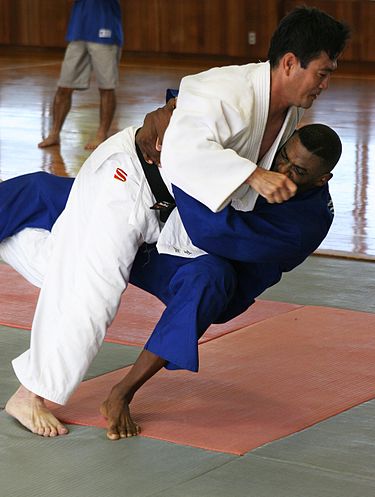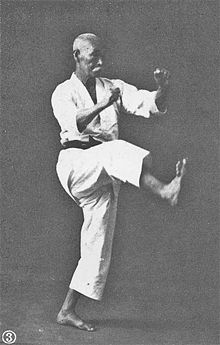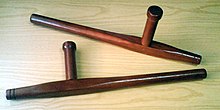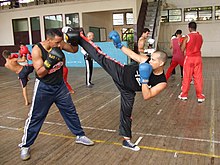Portal:Martial arts
The Martial Arts Portal

Martial arts are codified systems and traditions of combat practiced for a number of reasons such as self-defence; military and law enforcement applications; competition; physical, mental, and spiritual development; entertainment; and the preservation of a nation's intangible cultural heritage. (Full article...)
Although the earliest evidence of martial arts goes back millennia, the true roots are difficult to reconstruct. Inherent patterns of human aggression which inspire practice of mock combat (in particular wrestling) and optimization of serious close combat as cultural universals are doubtlessly inherited from the pre-human stage and were made into an "art" from the earliest emergence of that concept. Indeed, many universals of martial art are fixed by the specifics of human physiology and not dependent on a specific tradition or era.
Specific martial traditions become identifiable in Classical Antiquity, with disciplines such as shuai jiao, Greek wrestling or those described in the Indian epics or the Spring and Autumn Annals of China. (Full article...)
Selected articles
Selected biography
Riner went undefeated between October 2010 and February 2020 before his winning streak was finally ended by Japanese judoka Kokoro Kageura in the third round of the 2020 Grand Slam Paris, marking Riner's first defeat in nearly a decade after 152 consecutive victories. (Full article...)
Selected entertainment
Mary Kom is a 2014 Indian Hindi-language biographical sports film based on the life of the eponymous boxer Mary Kom, directed by Omung Kumar and produced by Viacom18 Motion Pictures and Sanjay Leela Bhansali. The film stars Priyanka Chopra in the lead role, with newcomer Darshan Kumar and Sunil Thapa in the supporting roles of her husband and mentor, respectively, and depicts Kom's journey from becoming a boxer to her victory at the 2008 World Boxing Championships in Ningbo. The film marks the Hindi playback singing debut of Chopra, who provided her vocals for a song named "Chaoro" (a Meiteilon lullaby).
Mary Kom was developed by the writer Saiwyn Quadras, who suggested the storyline to Kumar when Kom was not a familiar name in India despite her numerous achievements. Kumar met Kom to ask her permission for the film, before her bronze medal victory at the 2012 Summer Olympics, which brought her recognition. Chopra underwent extensive physical training for four months to attain a muscular physique and learned the sport and Kom's distinct boxing style. Principal photography started in June 2013 at Filmistan, where the boxing sequences were filmed. After plans to shoot in Kom's hometown, Manipur, were dropped due to safety concerns, Mary Kom was shot in Dharamshala and Manali, where a major portion of Manipur was recreated.
The film premiered at the 2014 Toronto International Film Festival, becoming the first Hindi film to be screened on the opening night of the festival. Made on a budget of ₹38 crore (US$4.6 million), Mary Kom was released on 5 September 2014 to generally positive reviews with praise for Chopra's performance. Upon its release, the film recorded the highest opening weekend of all time for a female-led Indian film. The film was a box office success, grossing ₹86.19 crore (US$10 million) at the box office. Mary Kom is also ranked among the highest-grossing Indian films led by a female actor.
Mary Kom received several accolades at award ceremonies across India. The film won the National Film Award for Best Popular Film Providing Wholesome Entertainment and was nominated for the Filmfare Award for Best Film and Best Actress for Chopra. Additionally, Chopra won the Screen Award and the Producers Guild Film Award for Best Actress in a Leading Role.
Sports portals
Selected image
 |
Judo (Japanese: 柔道, Hepburn: Jūdō, lit. 'gentle way') is an unarmed modern Japanese martial art, combat sport, Olympic sport (since 1964), and the most prominent form of jacket wrestling competed internationally. Judo was created in 1882 by Kanō Jigorō (嘉納 治五郎) as an eclectic martial art, distinguishing itself from its predecessors (primarily Tenjin Shinyo-ryu jujutsu and Kitō-ryū jujutsu) due to an emphasis on "randori" (乱取り, lit. 'free sparring') instead of kata (形, kata, pre-arranged forms) alongside its removal of striking and weapon training elements. Judo rose to prominence for its dominance over established jujutsu schools in tournaments hosted by the Tokyo Metropolitan Police Department (警視庁武術大会, Keishicho Bujutsu Taikai), resulting in its adoption as the department's primary martial art. A judo practitioner is called a "judoka" (柔道家, jūdōka, lit. 'judo performer'), and the judo uniform is called "judogi" (柔道着, jūdōgi, lit. 'judo attire'). (Full article...)
General images -
Selected quote
Topics
- Regional origin - China - Europe - India - Indonesia - Japan - Korea - Philippines
- Unarmed techniques - Chokehold - Clinch - Footwork - Elbow strike - Headbutt - Hold - Kick - Knee strike - Joint lock - Punch - Sweep - Takedown - Throw
- Weapons - Archery - Duel - Knife fighting - Melee weapons - Shooting - Stick-fighting - Swordsmanship - Nunchaku
- Training - Kata - Practice weapon - Punching bag - Pushing hands - Randori - Sparring
- Striking - Boxing - Capoeira - Karate - Kickboxing - Muay Thai - Lethwei - Sanshou - Savate - Taekwondo - Vovinam
- Internal - Aikido - Aikijutsu - Baguazhang - Tai chi - Xing Yi Quan
- Full contact / Combat sports - Professional boxing - Professional kickboxing - Knockdown karate - Mixed martial arts - Pankration - Submission wrestling
- Self-defense / Combatives - Arnis - Bartitsu - Hapkido - Kajukenbo - Krav Maga - MCMAP - Pencak Silat - Systema - Wing Chun - Legal aspects
- Eclectic / Hybrids - American Kenpo - Chun Kuk Do - Jeet Kune Do - Shooto - Shorinji Kempo - Unifight
Categories
Things you can do
See the list on the right of Martial art related projects who organise work on these articles. You can also add your self to the list of Wikipedians by martial art
Talk page tagging
If you come across a martial arts related article, adding the project template {{WikiProject Martial arts}} to the talk page will help identify them for improvement and linking to related articles. For Boxing, Fencing, Mixed martial arts and Sumo. Use {{WikiProject Boxing}}, {{WikiProject Fencing}}, {{WikiProject Mixed martial arts}} and {{WikiProject Sumo}} respectively.
- Assessment
- If possible please assess articles you tag using guidelines (Boxing, Mixed martial arts and Sumo).
Deletions
Monitor and contribute to deletion debates (Boxing).
Find images
Wikipedia requested images of martial artists, mixed martial artists and boxers.
Associated Wikimedia
The following Wikimedia Foundation sister projects provide more on this subject:
-
Commons
Free media repository -
Wikibooks
Free textbooks and manuals -
Wikidata
Free knowledge base -
Wikinews
Free-content news -
Wikiquote
Collection of quotations -
Wikisource
Free-content library -
Wikiversity
Free learning tools -
Wikivoyage
Free travel guide -
Wiktionary
Dictionary and thesaurus

























































































